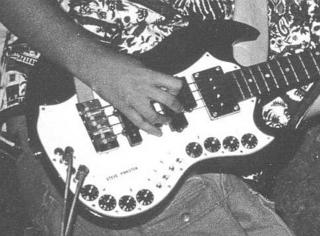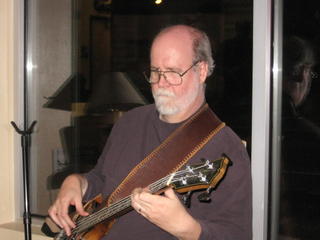I'm talking about your neck, of course.
That is...the neck of your bass.
Bass guitars, like string basses, come in different sizes. The primary measure is the scale length -- the distance the string spans between the bridge and the nut. Leo Fender's original Precision bass had a scale length of 34 inches. When Gibson got into building electric basses a few years later, they used a scale length of about 30.5 inches. Most modern basses are built to a scale length of 34" or longer.
For better or worse, my first electric bass was a 1965 Gibson EB-0. I had started out as a cello player, and then played electric guitar in several bands. I became accustomed to playing on the Gibson short scale, and found that I could play with a lot of speed, particularly because I played with a pick. The pick also imparted a brighter sound, partially offsetting the EB-0's deep, dark sound.
Once I got to L.A. and started making some decent money playing, I started seeking "improvements" in my tone, and the primary way I did this was by adding pickups and knobs. First was a Fender Jazz pickup near the bridge. Then came a Gibson EB-3 bridge pickup and a Fender Precision pickup. Pretty soon I had a genuine Frankenbass! I ran each signal out a separate jack to a mixer -- a quadraphonic bass!!!

A few years later, in 1973, I picked up a Gibson Les Paul Triumph bass, and that remains my main bass to this day.
All of this is a roundabout way to come to the subject of tone. Short-scale basses are perceived to be at a disadvantage tone-wise. The shorter string length means the same string will be at a lower tension to produce the same note. Lower tension means less sustain, fewer high frequencies, and a generally more indistinct tone. I do own one 34" scale bass, but I really play my best on the short Gibson. So I have had to learn how to get a good tone out of it in different settings.
Playing position:
Today I mainly play with my first two fingers (and occasionally my thumb) when playing in a jazz setting. I anchor my thumb on the neck pickup, and pluck the strings at different spots varying from directly over the neck pickup to almost directly over the bridge pickup. There are several "sweet spots" in there that maximize the tone for each string. Of cours, the closer to the bridge you pluck, the richer the tone will be in upper harmonics. One trick I use a lot is that if I'm trying to play a really sweet low note on the E string, I'll shift my fingers to play it closer to the bridge. This brings out the pitch and really lets it sing. Conversely, I'll sometimes play high notes on the G string by plucking near the neck to give them a mellow tone.

Strings:
Ah, the eternal quest for the perfect strings. When I started playing, flatwounds were all you could get. I always looked for the brightest-sounding flats possible, particularly for the E string. I often had a mis-matched set, if I found a particularly nice E. String technology has advanced a great deal since those days. I find that I get a nice full sound with modern roundwounds, and a good set that's made explicitly for short-scale instruments has just as much tension and sustain as a long-scale set.
Amp:
Your choice of amplifier is as personal as your choice of instrument or strings. There are choices to be made: tube vs. transistor; single big speaker vs. multi small speakers; and on and on. I have owned huge tube rigs (and I do mean HUGE -- my biggest rig had 2 18" speakers and 4 15" speakers, and 400 watts of amp). I've also owned a 2x15 Kustom transistor amp, a 2x15 Traynor tube amp, and I currently play through either a Roland Cube-30 (transistor, 1 10" speaker) or an SWR combo amp with a 15" speaker. Something I like to do is to crank the input level up and the output level down. This lets me "dig in" and get a little edge of distortion on the attack of the note if I want it. The Roland also has amp-modeling, a little compressor, and a couple of effects which is very cool.
Also, I have found that getting the amp up off the floor and tilting it back a little has a very positive effect on the tone, at least to my ears. I bought a collapsable stand that lifts the little Roland amp and tilts it back. For the larger SWR amp, I installed removable casters. If I pop the rear casters out, it tilts back quite nice nicely.
Well that's my little rant about bass tone. Feel free to post comments, rebuttals, etc.



No comments:
Post a Comment